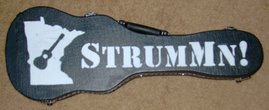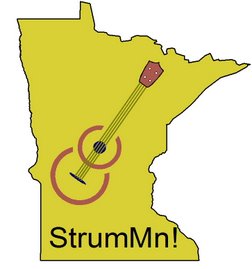Spent some time yesterday cutting and gluing up plexiglass for a circle jig. I have a nice adjustable one but it only goes to about 6" and I needed 9.75".
I'll need to add another hole later for removing most of the inside leaving ~0.5" ring to glue the top and back into place. I've got some nice wood picked out for this which I'll show later.
My first pattern with the pic glued on wasn't quite to size, about an 1/8" small and a bit uneven from cutting it free hand on the band saw. This is what prompted further measurement and the realization that the lower bout was basically 3/4 of a perfect circle. Thus the circle jig.
So after routing the "circle" to each piece I picked one to be my "new pattern". I had to play some tricks to hold the "old pattern" in place to use a router pattern bit to transfer the "point" sections of the body onto the new pattern. Basically a 1/2" straight bit with a 1/2" roller bearing. The bearing follows the pattern and the cutter section duplicates the pattern into the work piece. You have to be sure to have either a sacrificial piece of a "hold off" board like I used so the cutter can come through without hitting your workbench (or table saw deck like I used).
I also spent some time trying to recreate a floating bridge design I'd saved pics of years ago. These tests are just done in some soft cedar to get the method down, the final will be in rosewood. I'm not sure of the exact height or final width yet so I won't finalize until I get at least a blank fretboard in place.
This design hits on a cool process I've seen but never tried. That is running wood through the table saw at a diagonal! I learned that it's best to bring the blade up in small increments. Trying to do it full height the first time was frustrating and resulted in burned wood and an uneven surface. It was probably terrible for my bearing and blade as well. Live and learn! I also ran the work the wrong direction through the router table the first time. Doing this wrong causes the cutter to push the work piece away from the fence and on a small piece it really messed with my clearances. This also required an angle cut on both sides using the band saw. A tip here is to save the cutoff and put it back in place when running the second side to help keep things square. (Both can be used when routing the bottom too depending on order of operations. I think that I've settled on route first, table saw second, band saw third. But that could change.
Finally, I spent time trying to even up my fretboard sides from the band saw oversize cuts. I just used a bench top belt sander. Looking at it when done it looked too wide at the nut so out came the ruler again.
It WAS too wide, so I drew in new lines and will re-sand it tomorrow. Hopefully I can bring it to the lines without any more mishaps. I'm going to save the transition from neck to peghead and the volute until I can glue up the 3 pieces of ply and layout/cut the peghead at a 15 degree angle (or there about).
Brian












No comments:
Post a Comment